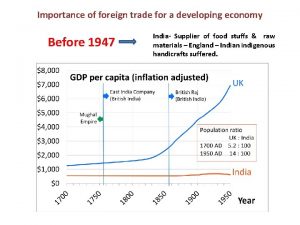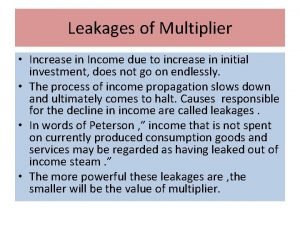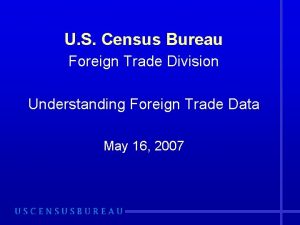Importance of foreign trade for a developing economy





- Slides: 5

Importance of foreign trade for a developing economy Before 1947 India- Supplier of food stuffs & raw materials – England – Indian indigenous handicrafts suffered.

After independence Need to extend its productive capacity at a faster rate. Why? Unable to import machinery & equipment at initial stage. A developing economy’ s essential Imports: Developmental imports Help to Create new capacity in one line production Enlarge capacity in another line Eg. Hydro electric projects, stetting up of steel plants. To make a full use of Productive capacity Maintenance imports Imports of raw materials & Intermidiate goods Eg. Industrial projects, stetting up of steel plants. Other Imports are Consumer goods Anti inflationary • To reduce scarcity of consumer goods Eg. Food grains imports after independence – arrested rise of price at home. External assistance will help in the short run and not in the long run. The long run the burden should be tolerated by the developing country itself.

Foreign trade since Independence 1. 1948 -49 to 1950 - 51 – On the Eve of Planning o Pent up demand for war and post war period o Shortage of food grains and basic raw materials jute & cotton o Rise in the imports of machinery and equipment or capital goods o To meet growing demand for hydro electric power 2. 1951 - 52 to 1955 – 56 - the First Plan period • Annual average value of imports during the I 5 Yr plan was Rs. 730/- crores & exports are Rs. 622/- crores (refer table 2) 3. 1956 - 57 to 1960 – 61 2 nd Plan period • Massive industrialisation was initiated – ( Steel Plant, Heavy Expansion & Renovation of railways, mordernisation of many industries (refer table 3)- foreign exchange crisis became acute. 4. 1961 -62 to 1965 - 66 – 3 rd Plan period • Volume of trade increased due to 3 factors: 1. Increased rapid industrialisation 2. Defense needs had increased due to china & Pakistan 3. Extensive failure of crops import of food grains

Continued… 5. Devaluation of 1966 and period up to 1973 - 74 • Persistent unfavourable balance of trade, foreign exchange crisis, extensive borrowing of international banks like IMF had pushed the economy to devaluate its currency by 36. 7% in June, 1966. • To reduce the volume of imports. To boost exports, to create balance of trade & payments. • But the result was unfavourable to the economy. 6. 1974 - 79: The fifth Plan period: • Hike of Oil Prices 1973 - world- India too (refer table 6) • Large imports are petroleum fertilizers and food grains • Imports like fish, fish preparations, coffee, tea, groundnuts, cotton fabrics and ready made garments & handicrafts.

Continued… 7. 1980 onwards; 6 th & 7 th Plan period (Table – 7) • Government approached IMF for a huge loan- Trade deficit • OPEC & POL led the govt. to import more with its hike price – Gulf War • ONGC given relax but the same time non imports of PL items – liberalization policy • Even in the 7 th plan too Adverse loan from IMF & Congress Govt Brakes the import licensing 8. 1989 - 90 Onwards: • The Directorate General of Commercial Intelligence and Statistics (DGCI&S), figures out that our exports were pushed up, but a results of Gulf War- the govt. Failed to curb imports. Trade deficit short up to 10, 635 crores. ( Table * 8) 9. Foreign trade during 8 th Plan(1992 -93 to 1996 -97): • Although the exports revealed pick up but due the liberalization of policies has affected our trade by reduction of custom duties. The deficit rose to 3 times. 10. Foreign trade during 9 th Plan(1997 -2002) & 10 th Plan(2002 -03 to 2006 -07): • (South Asian Crisis)1997 -98 Russian economic crisis made the world to fall out put by 2% later picked up. Trade deficit followed at ninth Plan. • Trade deficit of 10 th plan rose to 4 times annual average deficit of 9 th plan (Table 9). Appreciation of money will results the economy to reduce trade deficit.









